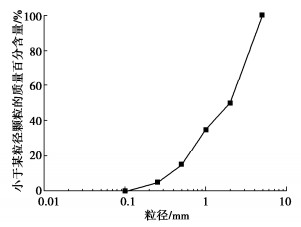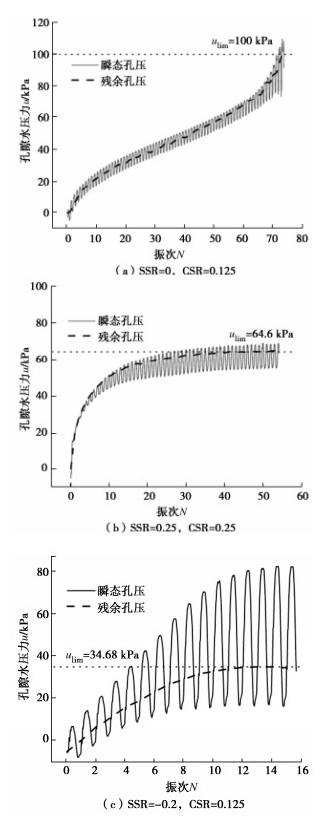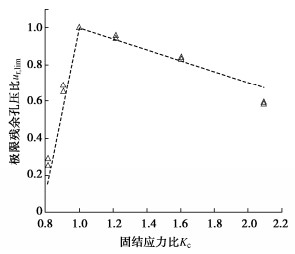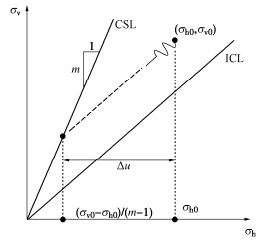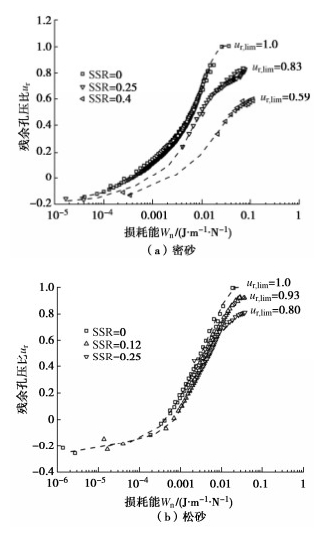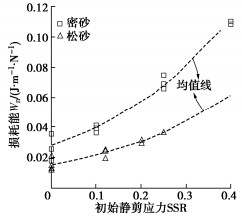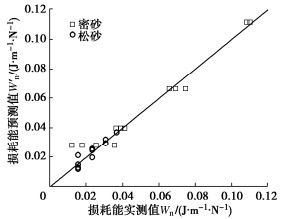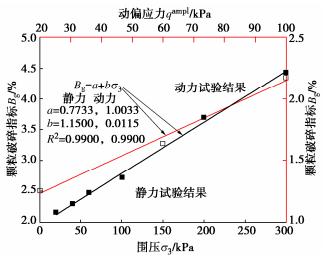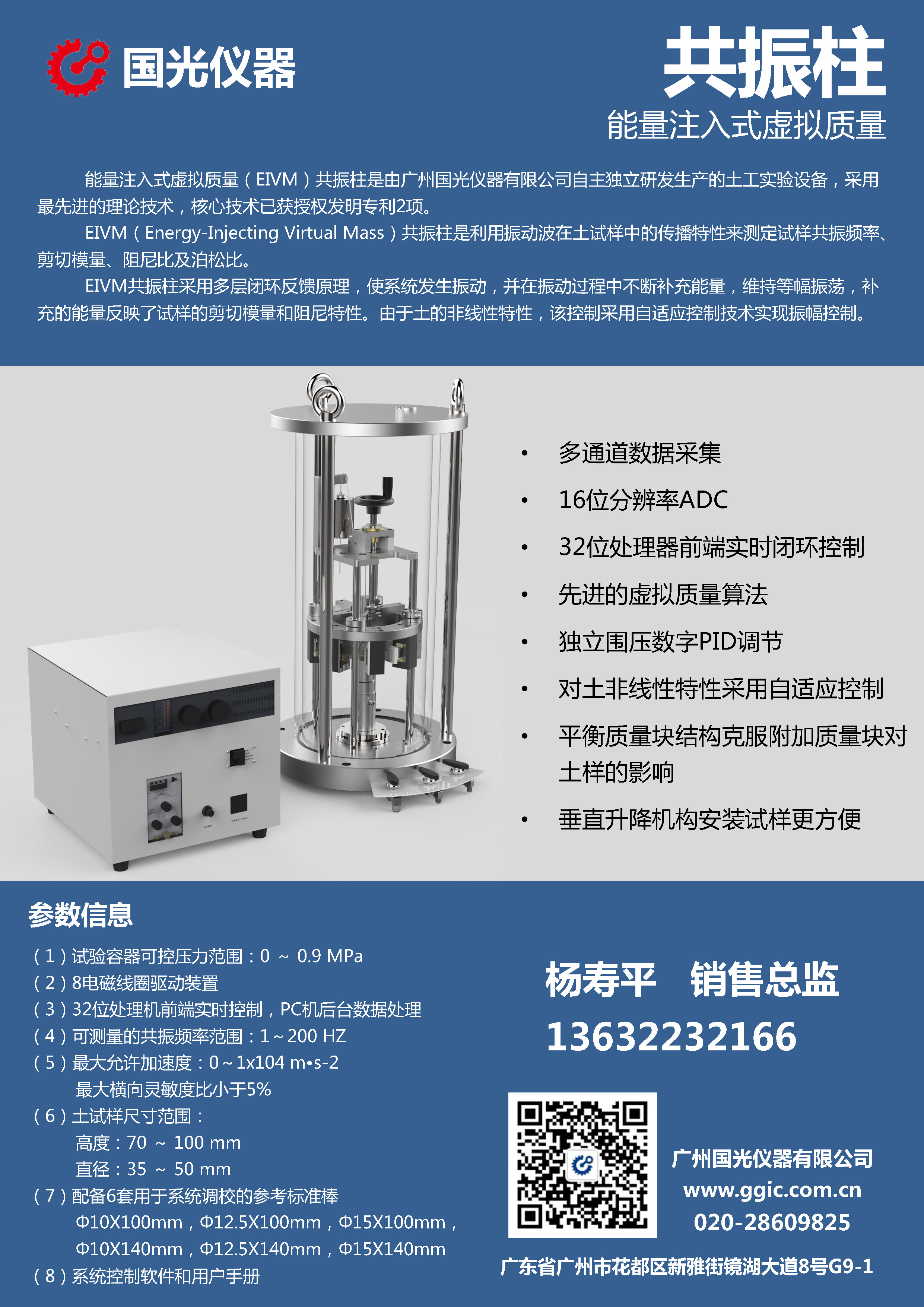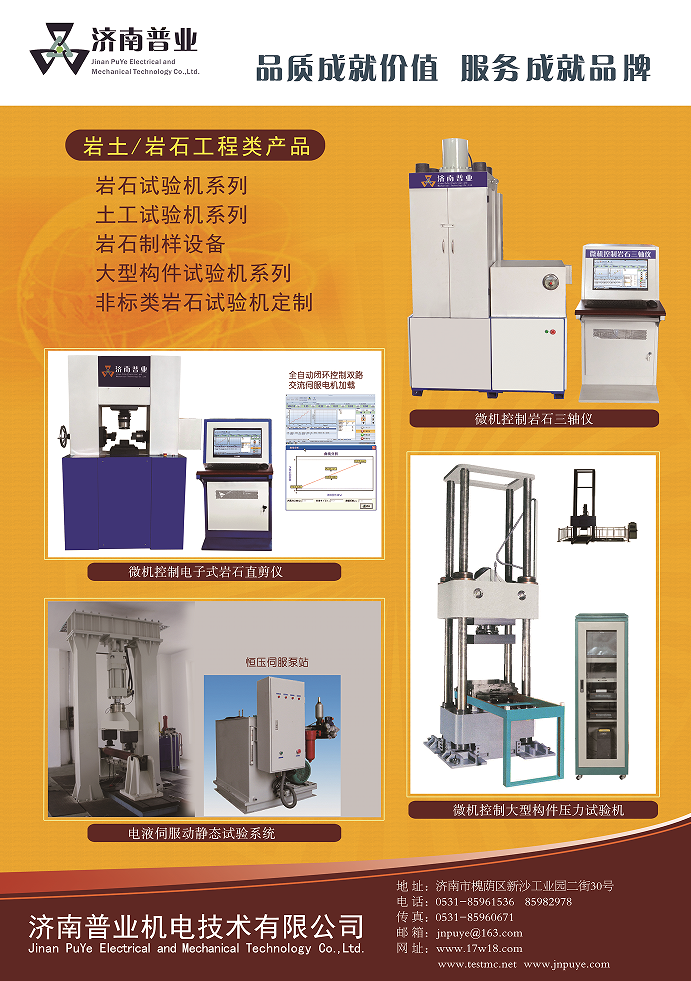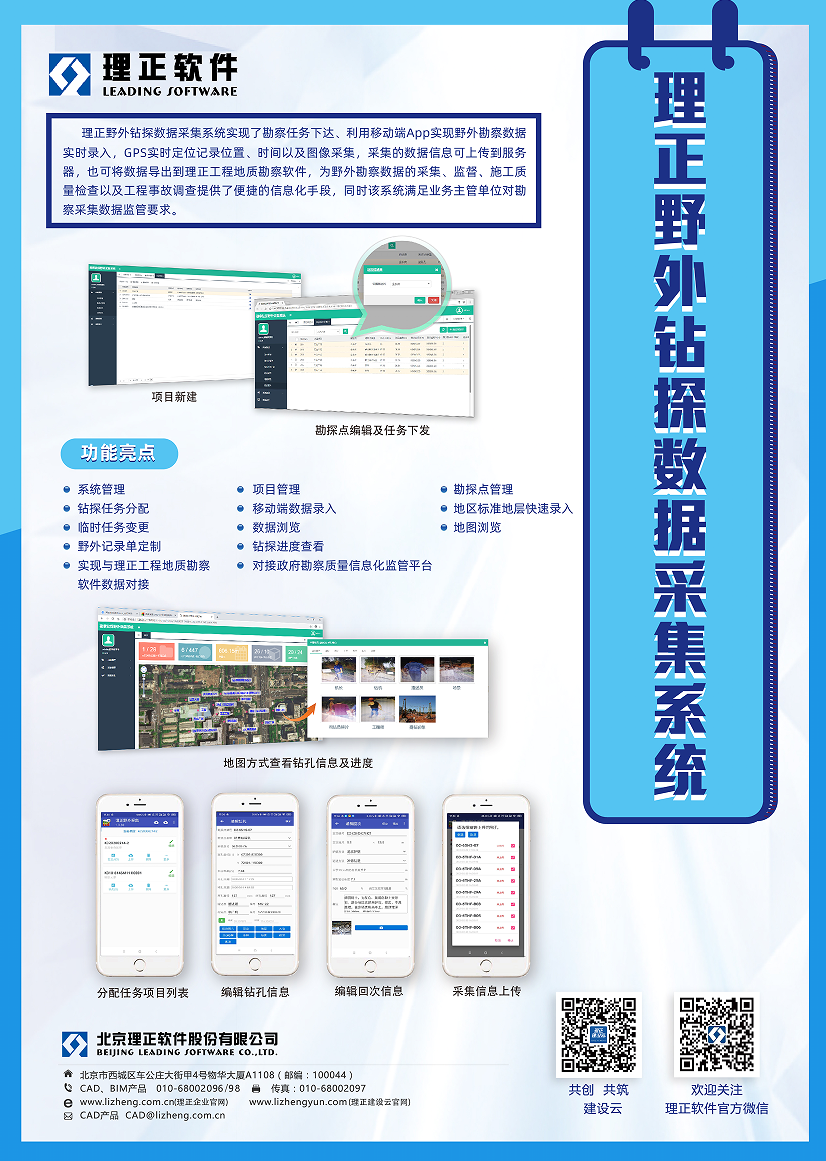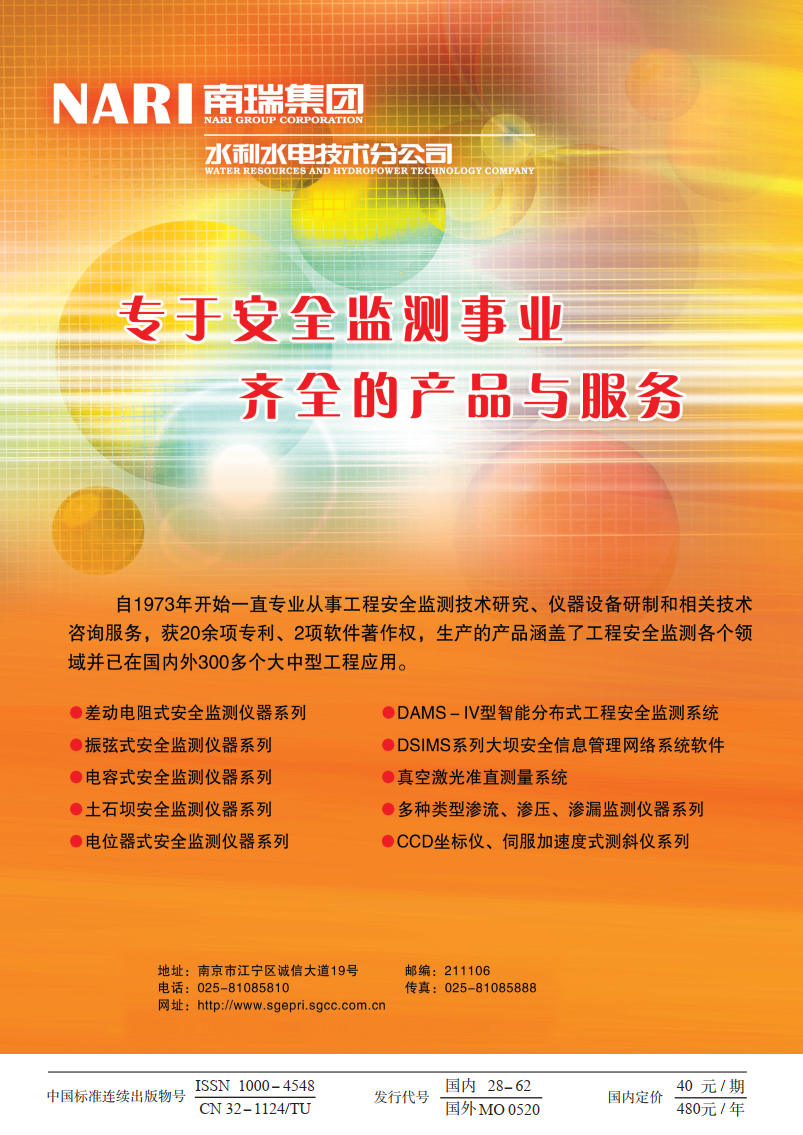Experimental study on mechanical characteristics of coarse-grained materials of subgrade under static-dynamic loading
-
摘要: 粗粒土因其良好的力学性能被广泛应用于路基建设中,但长期荷载作用下填料的变形严重影响了道路结构的安全运营。为了揭示典型路基应力水平及交通荷载条件下粗粒土的变形及强度演化,开展了一系列粗粒土填料静动力学特性试验,并进一步分析了静动力作用下填料破碎特征及差异。研究表明,低围压情况下,较小的轴向应变就可以使材料达到峰值应力状态,且围压的增加可显著提升填料峰值强度。不同围压下,填料在剪切过程中均出现剪胀现象,其中围压小于300 kPa试样的最终体应变均大于0。在动力试验中,填料轴向累积应变在相同加载次数下随着动偏应力的增加而增大,随围压的增加而减小,且前500次加载所造成的轴向应变占总应变的80%。静动力作用下的填料颗粒破碎形式存在差异,静荷载作用下的颗粒破碎主要以边角及整体断裂为主,而动荷载下主要以表面研磨和边角轻微断裂为主。Abstract: The coarse-grained soil is widely used as the filling materials in subgrade construction due to its excellent mechanical properties. However, the significant deformation of the filling materials caused by long-term loading severely impacts the safe operation of the roadbed structures. In order to reveal the deformation and strength evolution of the coarse-grained soil under typical subgrade stress levels and traffic loading conditions, a series of static-dynamic characteristic tests on the coarse-grained soil are conducted. Furthermore, an in-depth analysis is performed on the differences in the breakage characteristics under static-dynamic loading. The research indicates that under low confining pressure, a smaller axial strain can reach the peak stress state, and the increase in the confining pressure can significantly enhance the peak strength of the filling materials. Under different confining pressures, the fill materials exhibit shear expansion during the shearing process, with the final volumetric strain of samples under the confining pressures less than 300 kPa all exceeding 0. In the dynamic tests, the axial accumulation of the filling materials increases with the dynamic deviator stress, decreases with the confining pressure under the same load cycles, and the axial strain generated by the first 500 loading cycles constitutes 80% of the total strain. The particle breakage pattern in the filling materials under static and dynamic loading differs significantly. Under static loading, the particle breakage primarily occurs in the form of edge fractures and overall rupture. Conversely, under dynamic loading, it predominantly involves surface abrasion and slight edge fractures.
-
0. 引言
钙质砂是由珊瑚骨骼、贝类、虫黄藻类等海洋生物残骸沉积而成,其主要组成成分是碳酸钙[1-3],是我国南海岛礁吹填的主要材料。因其生成环境、成因以及物质组成等因素影响,钙质砂具有颗粒易破碎、形状极不规则、内孔隙发育、微观结构复杂等显著区别于陆源石英砂的特点[4-6]。随着“一带一路”国家战略和建设“海洋强国”政策方针的推进,研究钙质砂工程力学特性具有重要意义[7-9]。
钙质砂作为填方工程的天然材料,其应力状态复杂多变,土体受到各向异性应力状态影响而产生初始静剪应力,在建(构)筑物的自重和动荷载(波浪、地震和交通荷载等)作用下,易引起地基强度降低、变形过大以及液化失稳等灾害。实际上,动荷载作用下剪切应力做功将导致材料损伤效应的累积,不排水条件下表现为孔压增长。因此,可以将孔压的升高与土体颗粒在运动或重排过程中所耗损的能量建立关联。损耗能作为标量,相较于应力、应变等矢量,可直接数学叠加,大幅度降低分析难度。Nemat-Nasser等[10]首先提出了耗散能量的概念,建立其与残余孔压的关系,来有效地评估孔隙水压力的产生和发展过程。Kokusho[11]和Pan等[12]提出了土骨架破坏产生的单位体积耗散能与应变和残余孔压累积直接相关,为评价砂土在不规则循环应力条件下的抗液化能力提供了有效方法。总体而言,上述研究主要针对石英砂,能否适用于钙质砂仍需进一步探究。
本文以饱和钙质砂为研究对象,开展不排水条件下循环剪切三轴试验,探究相对密实度、初始静剪应力以及循环应力对其孔压发展的影响;同时,引入能量法,建立钙质砂孔压与损耗能之间联系,提出基于能量损耗的液化评价方法,为钙质砂地基稳定性分析提供理论依据和技术支撑。
1. 试验材料与方案
1.1 试验材料
本文试验材料为中国南海某岛礁的天然钙质砂,颗粒多呈灰白色,形状有片状、块状、棒状等,颗粒内孔隙多、微观结构复杂,如图 1所示。
经过现场取材、清水冲洗、烘干等过程后,对粒径大于5 mm的颗粒进行剔除,处理后颗粒分布级配曲线如图 2所示,主要基本物理性质参数见表 1。不难发现,试样基本不含0.1 mm以下的细颗粒,不均匀系数和曲率系数分别为6.84和0.78,属于不良级配砂土。
表 1 钙质砂物理性质指标Table 1. Physical properties of calcareous sand相对质量密度 d50/
mm不均匀系数 曲率系数 最大孔隙比 最小孔隙比 2.79 2.0 6.84 0.78 1.15 0.87 1.2 试验方案
结合实际工况,采用CKC三轴试验系统模拟复杂应力条件下饱和钙质砂循环剪切试验,先进行有效围压为100 kPa的等向固结后再根据试验设计的初始静偏应力状态进行非等向固结,具体方案如表 2所示。初始静剪应力比SSR和循环应力比CSR可通过式(1)和(2)计算。
表 2 不排水循环剪切试验方案Table 2. Summary of undrained cyclic triaxial tests试验系列 相对密实度
Drqs/
kPaqcyc/
kPaSSR CSR Nf Ⅰ 70%
(密砂)0 20 0 0.1 232 0 25 0 0.125 74 0 30 0 0.15 17 0 40 0 0.2 6 20 30 0.1 0.15 168 20 45 0.1 0.225 19 20 50 0.1 0.25 3 50 50 0.25 0.25 53 50 60 0.25 0.3 11 50 70 0.25 0.35 6 80 70 0.4 0.35 14 80 80 0.4 0.4 7 -10 25 -0.05 0.125 78 -10 30 -0.05 0.15 39 -10 35 -0.05 0.175 8 -20 20 -0.1 0.1 210 -20 25 -0.1 0.125 11 -20 30 -0.1 0.15 8 -40 20 -0.2 0.1 57 -40 25 -0.2 0.125 16 -40 30 -0.2 0.15 8 Ⅱ 30%
(松砂)0 15 0 0.075 943 0 20 0 0.1 120 0 25 0 0.125 37 0 30 0 0.15 18 24 30 0.12 0.15 61 24 35 0.12 0.175 16 24 40 0.12 0.2 5 40 15 0.2 0.075 175 40 20 0.2 0.1 9 50 12.5 0.25 0.0625 17 50 15 0.25 0.075 2 -10 12.5 -0.05 0.0625 382 -10 15 -0.05 0.075 180 -10 20 -0.05 0.1 11 -20 10 -0.1 0.05 246 -20 12.5 -0.1 0.0625 202 -20 15 -0.1 0.075 12 -40 5 -0.2 0.025 104 -40 7.5 -0.2 0.0375 13 -40 10 -0.2 0.05 2 SSR=qs2p′0, (1) CSR=qcyc2p′0。 (2) 式中:qs为初始静剪偏应力;qcyc为循环偏应力;p′0为平均有效正应力。
2. 试验结果与分析
2.1 孔压特性发展规律
图 3给出不同初始偏应力作用下饱和密砂的孔压发展规律曲线。孔隙水压力可分为两类:①随着循环荷载作用实时变化的孔压,即实线所示的瞬态孔压,这种孔压会随着循环荷载的卸载而快速消散;②每个循环加载结束,试样未及时恢复的孔压,即虚线所示的残余孔压。从图 3(a)中可以看出,对于等向固结的试样,残余孔压在前期随着荷载的施加而逐渐累积,而在后期快速增长,直至达到荷载施加前的有效围压,ulim=100 kPa。如图 3(b)所示,在压缩静偏应力作用下,孔压在加载初期迅速累积,随着循环荷载持续进行,残余孔压逐渐趋于稳定,ulim=64.6 kPa。在拉伸静偏应力作用下,孔压发展与压缩静偏应力时有类似的变化趋势,孔压在加载初期累积较快而后基本保持不变,ulim=34.68 kPa。
同时,通过式(3)和(4)定义固结应力比Kc和残余孔压比ur。
Kc=σv0σh0, (3) ur=uσh0。 (4) 式中:σv0和σh0分别为初始有效竖向应力和水平应力,u为残余孔压。
图 4给出了饱和密砂的极限残余孔压比和固结应力比的关系曲线。从图中可以看出,饱和密砂的极限残余孔压比随着固结应力比的增大呈先增大后减小的趋势,在Kc=1(等向固结)时,极限残余孔压比达到最大值ur, lim=1,且大致上呈线性分布,与循环应力幅值大小无明显关系。
对于同一材料的砂土,其在循环荷载作用下有效应力路径将沿着平行于等向固结线(ICL)的方向逐渐靠近临界状态线(CSL),而与循环应力幅值无关,如图 5所示。因此,对于给定的初始应力状态(σh0,σv0),会与临界状态线相交于一点,且理论上初始应力点与最终应力点之间的水平距离Δu为试验中的极限残余孔压,如式(5)所示。根据ur和Kc定义,可得到两者关系如式(6),符合图 4所示的线性关系。
ulim=Δu=σh0−σv0−σh0m−1, (5) ur, lim=ulimσh0=1−Kc−1m−1。 (6) 2.2 损耗能演化规律
动荷载作用下饱和砂土损耗的能量主要用于颗粒的相对运动和重新排列。因此,引入能量法,提出基于损耗能的砂土液化评价方法。循环加载过程中一个振次的损耗能W可用应力-应变滞回圈的面积表示,即:
W=n−1∑i=112(qi+1+qi)(εa, i+1−εa, i)。 (7) 式中:n为计算增量的总个数,qi和εa, i分别为第i个增量的偏应力和轴向应变。
图 6分别给出饱和钙质砂在不同初始静偏应力作用下残余孔压比与正交化损耗能的内在关系,正交化损耗能Wn为损耗能W与初始有效水平正应力σh0的比值。结果显示:饱和密砂的残余孔压初期增长缓慢,随着Wn的增大而较快增长,最后趋于稳定;在饱和松砂中也观察到类似的变化趋势。这说明残余孔压与损耗能的关系主要取决于初始应力条件。
从图 7可以看出,饱和钙质砂在失稳破坏时所积累的损耗能随着初始静剪应力的增加而增加;对于同一初始应力状态,密砂所需能量始终大于松砂。研究表明[13-14],饱和砂土在循环荷载作用下损耗能主要与初始应力和相对密实度有关,受循环荷载幅值影响极小,具体可用式(8)表示:
W′n=10a(Dr−0.78)10b(SSR−1.0)。 (8) 式中:a和b为经验参数,根据本次试验数据可分别取0.65,1.5。图 8对损耗能的试验实测值与通过式(8)所得的预测值进行对比,发现两者基本落在斜率为1的对角线两侧,表明能量模型可较好地预测不同试验条件下饱和钙质砂的损耗能。
3. 结论
(1)饱和钙质砂的极限残余孔压比随固结应力比呈先增大后减小的趋势,在Kc=1时存在最大值,临界状态理论可以解释此现象。
(2)不排水循环加载条件下饱和钙质砂的损耗能与试样的初始静剪应力比和相对密实度有关,受循环应力比影响极小,可通过构建的能量模型较好地预测不同试验条件下饱和钙质砂所累积的损耗能。
-
表 1 粗粒土力学特性分析试验方案
Table 1 Schemes of analysis of mechanical properties of soil-rock mixtures
试验编号 σ3/kPa qampl/kPa N SL1 20 — — SL2 40 — — SL3 60 — — SH1 100 — — SH2 200 — — SH3 300 — — D1 20 20, 60, 100 10000 D2 40 20, 60, 100 10000 D3 60 20, 60, 100 10000 -
[1] SEIF EL DINE B, DUPLA J C, FRANK R, et al. Mechanical characterization of matrix coarse-grained soils with a large-sized triaxial device[J]. Canadian Geotechnical Journal, 2010, 47(4): 425-438. doi: 10.1139/T09-113
[2] 吕玺琳, 程博文, 张甲峰, 等. 含水率对土石混合料力学特性影响试验研究[J]. 地基处理, 2023, 5(2): 97-104. https://www.cnki.com.cn/Article/CJFDTOTAL-DJCL202302002.htm LÜ Xilin, CHENG Bowen, ZHANG Jiafeng, et al. Experimental study on the influence of moisture content on the mechanical properties of soil-rock mixture[J]. Journal of Ground Improvement, 2023, 5(2): 97-104. (in Chinese) https://www.cnki.com.cn/Article/CJFDTOTAL-DJCL202302002.htm
[3] XU M, HONG J T, SONG E X. DEM study on the effect of particle breakage on the macro- and micro-behavior of rockfill sheared along different stress paths[J]. Computers and Geotechnics, 2017, 89: 113-127. doi: 10.1016/j.compgeo.2017.04.012
[4] 吕玺琳, 马一跃, 徐柯锋, 等. 含砾量对土石混合料力学特性影响离散元模拟[J]. 路基工程, 2022(4): 19-23. https://www.cnki.com.cn/Article/CJFDTOTAL-LJGC202204004.htm LÜ Xilin, MA Yiyue, XU Kefeng, et al. Discrete element simulation of lnfluence of gravel content on mechanical properties of soil-rock mixture[J]. Subgrade Engineering, 2022(4): 19-23. (in Chinese) https://www.cnki.com.cn/Article/CJFDTOTAL-LJGC202204004.htm
[5] ZHANG Z L, XU W J, XIA W, et al. Large-scale in-situ test for mechanical characterization of soil-rock mixture used in an embankment dam[J]. International Journal of Rock Mechanics and Mining Sciences, 2016, 86: 317-322. doi: 10.1016/j.ijrmms.2015.04.001
[6] 吕玺琳, 庞博, 朱长根, 等. 桩承式路堤桩土荷载分担特性物理模型试验研究[J]. 岩土工程学报, 2022, 44(增刊2): 50-53. doi: 10.11779/CJGE2022S2011 LÜ Xilin, PANG Bo, ZHU Changgen, et al. Physical model tests on load-sharing characteristics of piles and soils in pile-supported embankment[J]. Chinese Journal of Geotechnical Engineering, 2022, 44(S2): 50-53. (in Chinese) doi: 10.11779/CJGE2022S2011
[7] TRINH V N, TANG A M, CUI Y J, et al. Mechanical characterisation of the fouled ballast in ancient railway track substructure by large-scale triaxial tests[J]. Soils and Foundations, 2012, 52(3): 511-523. doi: 10.1016/j.sandf.2012.05.009
[8] HARKNESS J, ZERVOS A, LE PEN L, et al. Discrete element simulation of railway ballast: modelling cell pressure effects in triaxial tests [J]. Granular Matter, 2016, 18(3): 65. doi: 10.1007/s10035-016-0660-y
[9] LIU S S, HUANG H, QIU T, et al. Effect of geogrid on railroad ballast particle movement[J]. Transportation Geotechnics, 2016, 9: 110-122. doi: 10.1016/j.trgeo.2016.08.003
[10] CAO Z G, CHEN J Y, CAI Y Q, et al. Long-term behavior of clay-fouled unbound granular materials subjected to cyclic loadings with different frequencies[J]. Engineering Geology, 2018, 243: 118-127. doi: 10.1016/j.enggeo.2018.06.019
[11] CAI Y Q, CHEN J Y, CAO Z G, et al. Influence of grain gradation on permanent strain of unbound granular materials under low confining pressure and high-cycle loading[J]. International Journal of Geomechanics, 2018, 18(3): 04017156. doi: 10.1061/(ASCE)GM.1943-5622.0001054
[12] 公路路基设计规范: JTGD30—2015[S]. 北京: 人民交通出版社, 2015. Specifications for Design of Highway Subgrades: JTGD30—2015[S]. Beijing: China Communications Press, 2015. (in Chinese)
[13] 铁路路基设计规范: TB10001—2016[S]. 北京: 中国铁道出版社, 2016. Code for Design of Railway Earth Structure: TB10001—2016[S]. Beijing: China Railway Publishing House, 2016. (in Chinese)
[14] WICHTMANN T, NIEMUNIS A, TRIANTAFYLLIDIS T. Strain accumulation in sand due to cyclic loading: drained triaxial tests[J]. Soil Dynamics and Earthquake Engineering, 2005, 25(12): 967-979. doi: 10.1016/j.soildyn.2005.02.022
[15] MARSAL R J. Large scale testing of rockfill materials[J]. Journal of the Soil Mechanics and Foundations Division, ASCE, 1967, 93(2): 27-43. doi: 10.1061/JSFEAQ.0000958



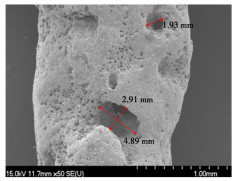
 下载:
下载:
